The Influence of Stability in New Power Systems with the Addition of Phase Modulation Functions in Thermal Power Units
Abstract
1. Introduction
2. Analysis on Influence of Phase Modulation Function Modification of Thermal Power Units on the Stability of New Power System
2.1. Analysis and Selection of Stability Evaluation Indicators for New Power Systems
2.1.1. Transient Voltage Stability Indicator for Voltage Dips
2.1.2. Transient Voltage Stability Indicator for Overvoltage Conditions
2.1.3. Construction of Effective Short-Circuit Ratio Evaluation Indicator for Multi-Infeed Systems
2.1.4. Construction of the Transient Power Angle Stability Evaluation Index
2.1.5. Construction of the Static Voltage Stability Evaluation Index
2.1.6. Construction of the Load Margin Evaluation Index
2.1.7. Construction of the Power Flow Transfer Entropy Evaluation Index
2.2. Construction of the Evaluation System for Enhancing the Stability of the Receiving-End Power Grid Through Adding Phase Modulation Function to Thermal Power Units
2.2.1. Quantitative Screening of Indices
- Determine the weight vector of evaluation indices using the AHP.
- Calculate the Gray relational coefficient [35].
- Calculate the Gray relational degree.
- Calculate the comprehensive Gray relational degree.
- Screening of evaluation indices.
2.2.2. Rationality Test of Indices
3. Quantitative Evaluation Method
3.1. Calculation of Comprehensive Subjective and Objective Weights
3.2. Fuzzy Comprehensive Evaluation Method
- Determine the evaluation index set and evaluation grade set.
- Construct the membership function model.
- Constructing the Fuzzy Evaluation Matrix.
- Fuzzy Comprehensive Evaluation Score.
4. Simulation Verification
4.1. System Overview
4.2. Comparison of System Evaluation Before and After Thermal Power Unit Retrofitting Under Different Bus Faults
4.3. Discussion
5. Conclusions
- (1)
- Adding a phase modulation function to thermal power units can improve the system voltage drop and overshoot indices, effectively suppress voltage drop and overshoot phenomena, and provide stable dynamic reactive power support for the power system.
- (2)
- For nodes with a high penetration rate of renewable energy, the volatility and uncertainty of the power system increase. After adding phase modulation function to thermal power units, the transient power angle stability index and static voltage stability index are improved, effectively improving the transient stability of the system and reducing the risk of system instability caused by renewable energy fluctuations.
- (3)
- After adding phase modulation function to thermal power units, the multi-feed short-circuit ratio index has been improved, and the anti-interference ability of the system has been enhanced. It can quickly adjust the excitation current when dealing with short circuit faults, reduce the impact of short-circuit current on the system, and improve the operational flexibility of the system.
Author Contributions
Funding
Data Availability Statement
Conflicts of Interest
References
- Zhou, S.-C.; Li, Y.-F. Enhancing the resilience of the power system to accommodate the construction of the new power system: Key technologies and challenges. Front. Energy Res. 2023, 11, 1256850. [Google Scholar] [CrossRef]
- Peng, Y.-M.; Yang, Y.; Chen, M. Value Evaluation Method for Pumped Storage in the New Power System. Chin. J. Electr. Eng. 2023, 9, 26–38. [Google Scholar] [CrossRef]
- Tong, J.-L.; Liu, W.-S.; Mao, J.B. Role and Development of Thermal Power Units in New Power Systems. IEEE J. Radio Freq. Identif. 2022, 6, 837–841. [Google Scholar] [CrossRef]
- Li, Z.-W.; Cheng, Z.-P.; Liang, J. Distributed Cooperative AGC Method for New Power System with Heterogeneous Frequency Regulation Resources. IEEE Trans. Power Syst. 2023, 38, 4928–4939. [Google Scholar] [CrossRef]
- Li, Z.; Lv, P.; Ju, X.; Zhu, C. Research on carbon emission reduction Calculation of thermal power industry under double carbon background. In Proceedings of the 2022 IEEE 5th Advanced Information Management, Communicates, Electronic and Automation Control Conference (IMCEC), Chongqing, China, 16–18 December 2022. [Google Scholar] [CrossRef]
- Gou, H.-L.; Jiang, Q. Black Start Method and Coordinated Restoration Strategy of DC Receiving-end Power Grid Based on Hybrid Direct Current. Adv. Eng. Sci. 2023, 55, 70–79. [Google Scholar] [CrossRef]
- Cao, D.; Zhao, J.; Hu, W.; Ding, F.; Huang, Q.; Chen, Z. Attention enabled multi-agent DRL for decentralized volt-VAR control of active distribution system using PV inverters and SVCs. IEEE Trans. Sustain. Energy 2021, 12, 1582–1592. [Google Scholar] [CrossRef]
- Chae, M.; Cha, H.-Y.; Kim, H. Abnormal temperature and bias dependence of threshold voltage instability in p-GaN/AlGaN/GaN HEMTs. IEEE J. Electron Devices Soc. 2024, 12, 581–586. [Google Scholar] [CrossRef]
- Yan, H.-G.; Zhang, W. The Necessity and Feasibility of Hydrogen Storage for Large-Scale, Long-Term Energy Storage in the New Power System in China. Energies 2023, 16, 4837. [Google Scholar] [CrossRef]
- Cong, J.; Song, K. Review of energy storage technology for new energy power system. Adv. Technol. Electr. Eng. Energy 2014, 33, 53–59. [Google Scholar]
- Wei, Z.-F. Application of Distributed Energy Storage in New Power System. In Proceedings of the 11th International Conference on Power and Energy Systems (ICPES), Shanghai, China, 18–20 December 2021. [Google Scholar] [CrossRef]
- Ren, D.; Hou, J.; Xiao, J. Research on Development Potential and Path of New Energy Storage Supporting Carbon Peak and Carbon Neutrality. Electr. Power. 2023, 56, 17–25. [Google Scholar]
- Hao, L.; Chen, L.; Huang, Y. Challenges and Prospects of Primary Frequency Regulation of Coal-fired Thermal Power Units for New Power System. Power Syst. Autom. 2024, 48, 14–29. [Google Scholar]
- Yang, L.; Li, Y.; Chen, M. An accurate ladder-type ramp rate constraint derived from field test data for thermal power unit with deep peak regulation. IEEE Trans. Power Syst. 2024, 39, 1408–1420. [Google Scholar] [CrossRef]
- Li, C.-H.; Liu, M.-Y.; Guo, Y. Cost Analysis of Synchronous Condenser Transformed from Thermal Unit Based on LCC Theory. Processes 2022, 10, 1887. [Google Scholar] [CrossRef]
- Fu, H.; Sun, R.; Wang, J. Key technologies of adding a condenser function in thermal power units in the receiving end power grid given a background of carbon peak and neutrality. Power Syst. Prot. Control 2024, 52, 132–143. [Google Scholar]
- Jun, A.; Zhang, J.-Y.; Du, X.-Y. Enhance Transient Voltage Stability by Retrofitting Thermal Power Unit to Synchronous Condenser. In Proceedings of the 7th Asia Conference on Power and Electrical Engineering (ACPEE), Online, 16–17 April 2022. [Google Scholar] [CrossRef]
- Wang, F.; Yang, P.; Zhao, G.; Li, Q.; Liu, X.; Ma, S. Development and challenges of flexible operation technology for thermal power units in new power systems. Power Gener. Technol. 2024, 45, 189–198. [Google Scholar]
- Ma, H.; Liu, D.; Zhao, G. Power Grid Voltage Phasor Trajectory Fitting and Transient Stability Evaluation Index Construction Based on Alternate Direction Multiplier Method. Power Constr. 2023, 44, 136–147. [Google Scholar]
- Li, X.; Liu, C.; Xin, S. Coupling mechanism analysis and coupling strength evaluation index of transient angle stability and transient voltage stability. Chin. J. Electr. Eng. 2021, 41, 5091–5107. [Google Scholar]
- Guan, L.; Chen, Y.; Chen, H. An evaluation model of probability distribution of stability index based on new power system diagram deep learning considering the randomness of new energy. China South. Power Grid Technol. 2024, 18, 118–128+138. [Google Scholar]
- Sun, H.; Xu, S.; Xu, T. Research on Definition and Classification of Power System Security and Stability. CSEE 2022, 42, 7796–7809. [Google Scholar]
- GB 38755-2019; Code on Security and Stability for Power System. National Standard of the People’s Republic of China: Beijing, China, 2019.
- Li, S.; Duan, C.H.; Gao, Y. Classification Study of New Power System Stability Considering Stochastic Disturbance Factors. Sustainability 2023, 15, 16614. [Google Scholar] [CrossRef]
- Li, J.-C.; Li, R.-M.; Xun, C. Statistical Indicator System for New Generation Power System Construction. In Proceedings of the International Conference on Wireless Power Transfer (ICWPT), Weihai, China, 13–15 October 2023. [Google Scholar] [CrossRef]
- Zhu, L.; Jiang, T.; Xue, F. Evaluation of short-term active impact of low penetration of large-scale new energy caused by voltage drop. Power Syst. Autom. 2024, 1–18. Available online: http://kns.cnki.net/kcms/detail/32.1180.TP.20240814.1618.004.html (accessed on 15 December 2024).
- Li, X.; Fang, Y.; Wu, X. Quantitative index of transient voltage stability based on instability mechanism analysis. Electr. Power Autom. Equip. 2023, 43, 195–202. [Google Scholar] [CrossRef]
- Li, F. Short Circuit Ratio Index Considering HVDC Transient Characteristics. In Proceedings of the 6th ACEEE, Chengdu, China, 21–23 July 2023. [Google Scholar] [CrossRef]
- Lin, W.; Ren, X.; Zhang, G. Optimization of Voltage Ride-through Control Parameters of Renewable Energy Considering Power Angle Stability and Transient Overvoltage. Grid Technol. 2023, 47, 1323–1331. [Google Scholar] [CrossRef]
- Sadeghi, S.E.; Shahabi, M.; Akbari Foroud, A. A new approach for static voltage stability assessment in transmission networks in the presence of OLTC. Electr. Power Syst. Res. 2024, 236, 110941. [Google Scholar] [CrossRef]
- Yang, Y.; Huang, Q.; Li, P. Online prediction and correction control of static voltage stability index based on broad learning system. Expert Syst. Appl. 2022, 199, 117184. [Google Scholar] [CrossRef]
- Chintakindi, R.; Mitra, A. Wide-area voltage stability assessment using loading margin sensitivity for increasing linear load levels and wind power penetration. Electr. Power Syst. Res. 2024, 233, 110487. [Google Scholar] [CrossRef]
- Li, M.; Mei, W.; Liu, Y. Accurate Identification Method of Brittle Branches in Power Grid Based on Improved Load Flow Entropy Indexes. Power Syst. Technol. 2019, 43, 1026–1033. [Google Scholar] [CrossRef]
- Sevinç, A.; Gür, S.; Eren, T. Analysis of the Difficulties of SMEs in Industry 4.0 Applications by Analytical Hierarchy Process and Analytical Network Process. Processes 2018, 6, 264. [Google Scholar] [CrossRef]
- Ma, L.; Lu, Z.; Chang, L. Study of index system of economic operation of grid based on gray correlation degree. Power Syst. Prot. Control. 2011, 39, 22–26. [Google Scholar]
- Liu, Y.; Zhang, J.; Yang, X. Comprehensive Evaluation of Relay Protection Based on Expert Investigation and G1 Method. Power Grid Technol. 2020, 44, 3533–3539. [Google Scholar]
- Lin, Z.Z.; Wen, F.S. CRITIC-Based Node Importance Evaluation in Skeleton-Network Reconfiguration of Power Grids. IEEE Trans. Circuits Syst. II-Express Briefs. 2018, 65, 206–210. [Google Scholar] [CrossRef]
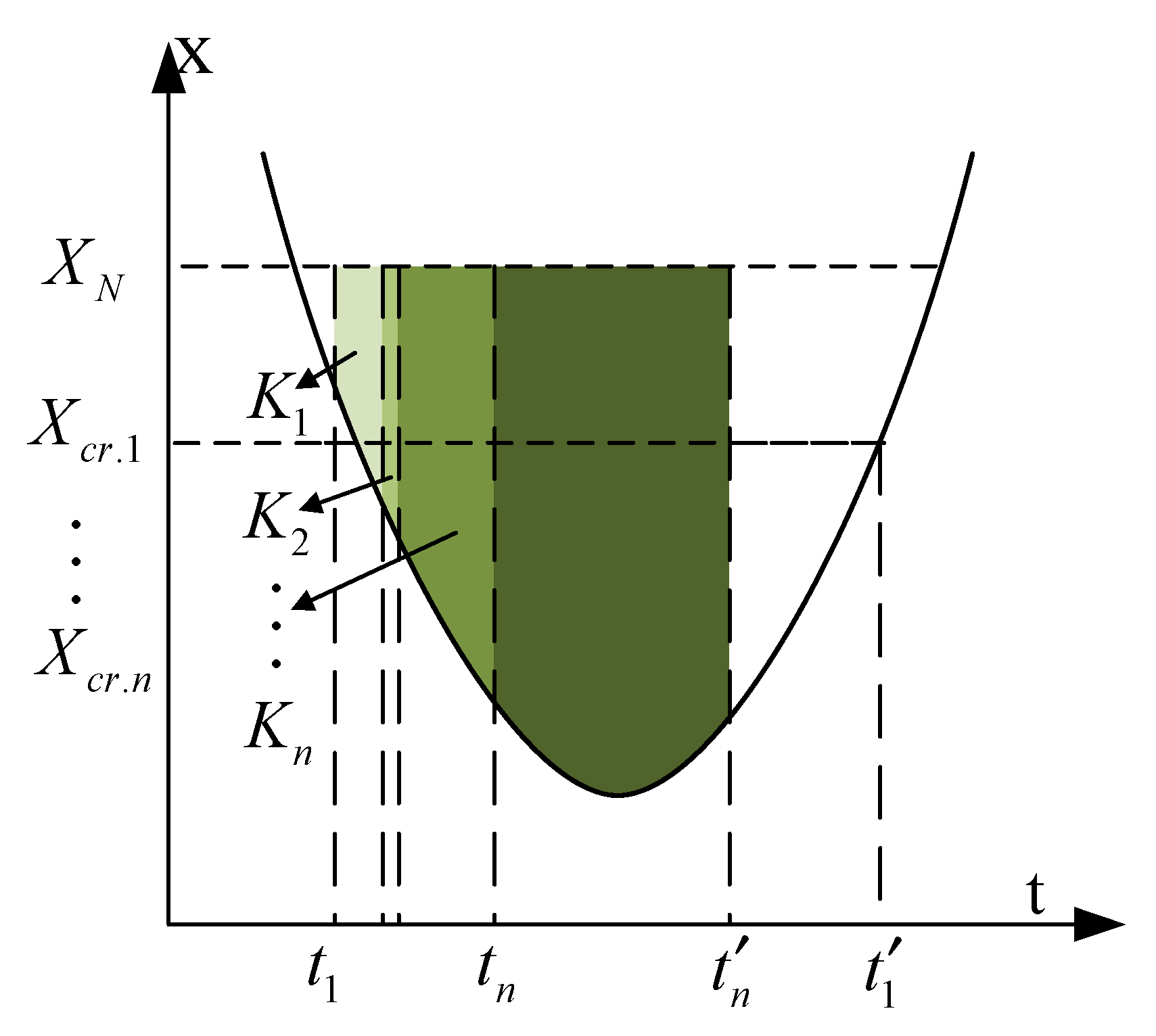
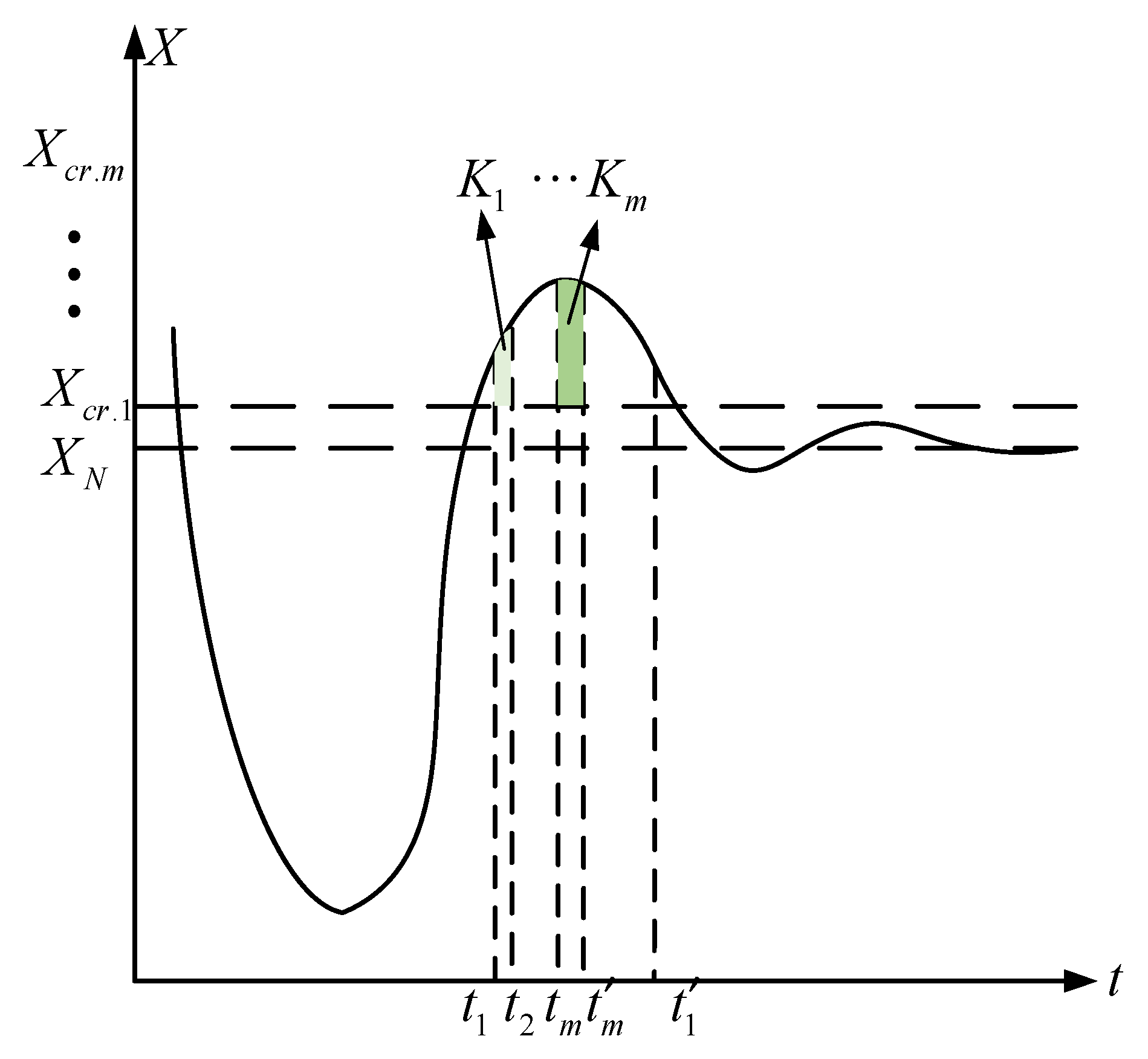


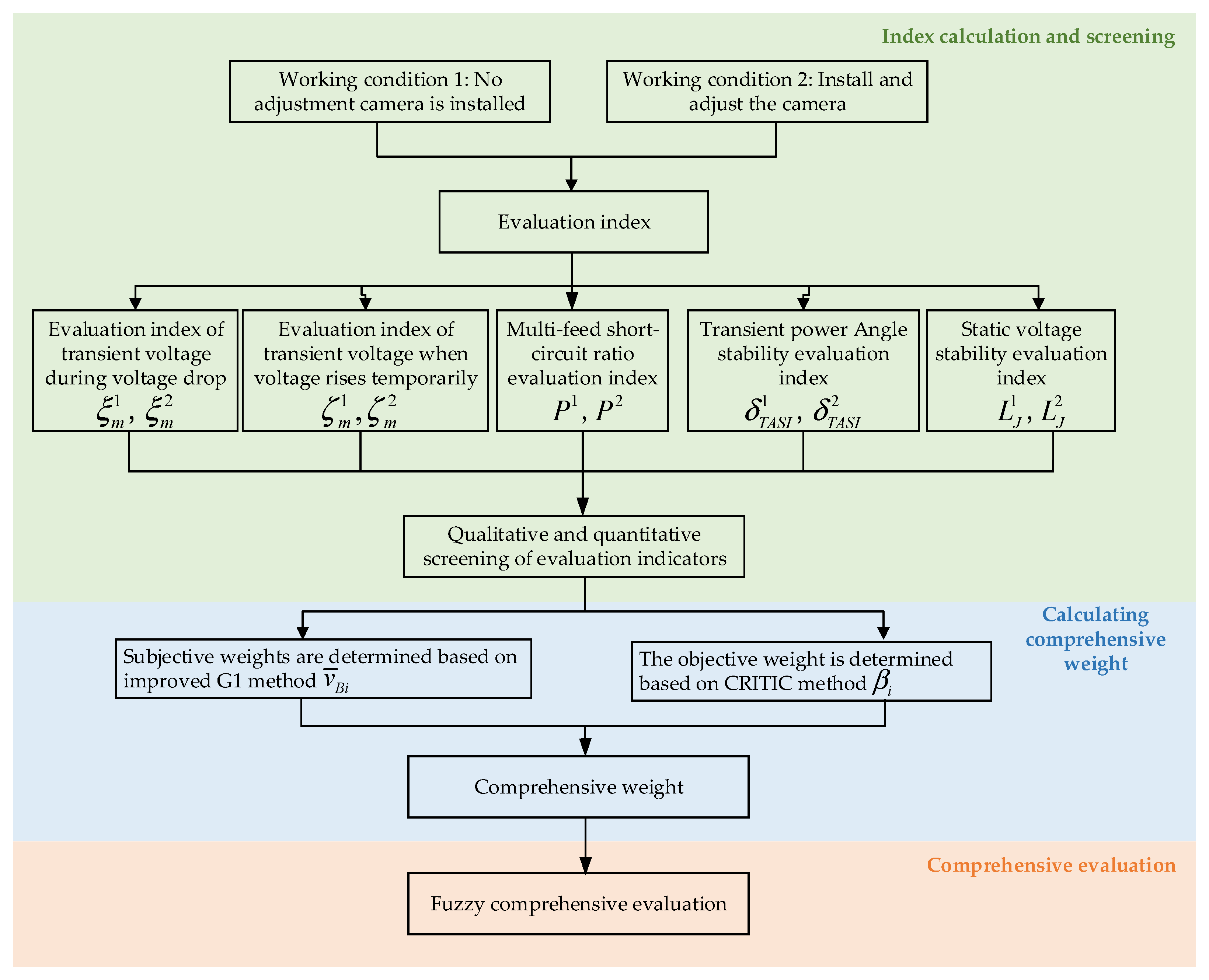


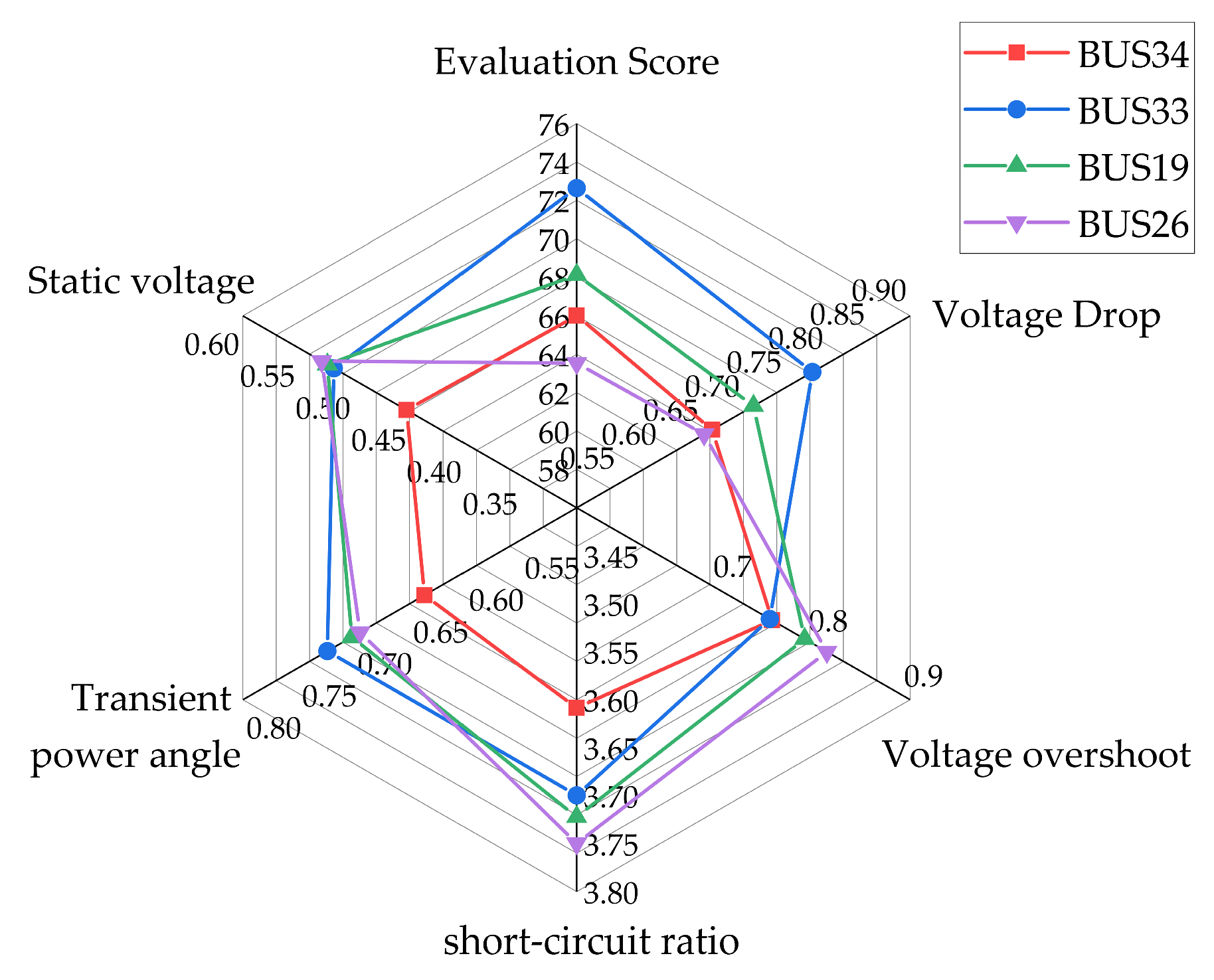
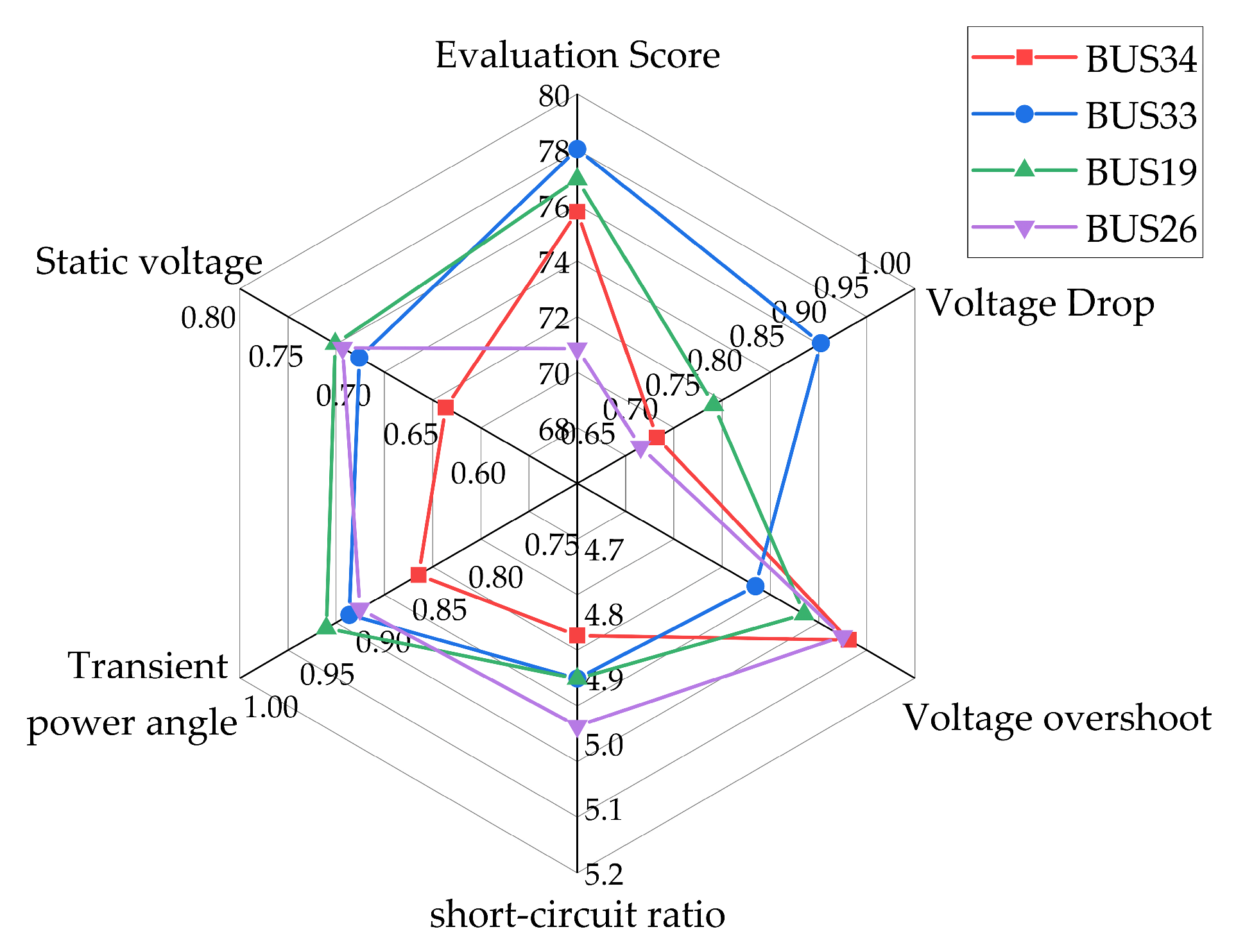

| V//Level | Percentage |
|---|---|
| v1A | 70–100 |
| v2B | 62–70 |
| v3C | 54–62 |
| v4D | 46–54 |
| v5E | 38–46 |
| v6F | 30–38 |
| v7G | 0–30 |
| Index | Membership Function Parameters | ||||||
|---|---|---|---|---|---|---|---|
| 0.8 | 0.7 | 0.6 | 0.5 | 0.4 | 0.3 | 0.2 | |
| 0.8 | 0.7 | 0.6 | 0.5 | 0.4 | 0.3 | 0.2 | |
| 3.5 | 3.25 | 3 | 2.75 | 2.5 | 2.25 | 2 | |
| 0.8 | 0.7 | 0.6 | 0.5 | 0.4 | 0.3 | 0.2 | |
| 0.8 | 0.7 | 0.6 | 0.5 | 0.4 | 0.3 | 0.2 | |
| Fault Bus\Score | Before Retrofitting | After Retrofitting |
|---|---|---|
| BUS34 | B(66.0145) | A(75.7719) |
| BUS33 | A(72.6398) | A(78.0199) |
| BUS19 | B(68.1397) | A(76.9347) |
| BUS26 | B(63.5372) | A(70.8428) |
Disclaimer/Publisher’s Note: The statements, opinions and data contained in all publications are solely those of the individual author(s) and contributor(s) and not of MDPI and/or the editor(s). MDPI and/or the editor(s) disclaim responsibility for any injury to people or property resulting from any ideas, methods, instructions or products referred to in the content. |
© 2024 by the authors. Licensee MDPI, Basel, Switzerland. This article is an open access article distributed under the terms and conditions of the Creative Commons Attribution (CC BY) license (https://creativecommons.org/licenses/by/4.0/).
Share and Cite
Liu, M.; Tian, C.; Yuan, X.; Li, C.; Gao, Z.; Zhang, D. The Influence of Stability in New Power Systems with the Addition of Phase Modulation Functions in Thermal Power Units. Processes 2024, 12, 2897. https://doi.org/10.3390/pr12122897
Liu M, Tian C, Yuan X, Li C, Gao Z, Zhang D. The Influence of Stability in New Power Systems with the Addition of Phase Modulation Functions in Thermal Power Units. Processes. 2024; 12(12):2897. https://doi.org/10.3390/pr12122897
Chicago/Turabian StyleLiu, Mingyang, Chunsun Tian, Xiaoling Yuan, Chenghao Li, Ze Gao, and Di Zhang. 2024. "The Influence of Stability in New Power Systems with the Addition of Phase Modulation Functions in Thermal Power Units" Processes 12, no. 12: 2897. https://doi.org/10.3390/pr12122897
APA StyleLiu, M., Tian, C., Yuan, X., Li, C., Gao, Z., & Zhang, D. (2024). The Influence of Stability in New Power Systems with the Addition of Phase Modulation Functions in Thermal Power Units. Processes, 12(12), 2897. https://doi.org/10.3390/pr12122897






